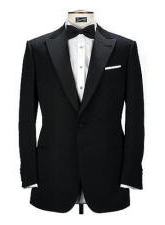Classic Black Tie: The Gold Standard

No matter what extremes Hollywood people go to in making black tie garish and tieless, the real thing retains its unassailable verve, élan and sheer swankiness.
Glenn O’Brien (GQ “Style Guy”)
The current definition of proper black tie, like most contemporary definitions throughout its past, provides options that can produce either a timeless look or a look relative to a specific era. While the relative look can be hit or miss (remember ruffled shirts?) the timeless look delivers optimal results every time: It makes a man look taller, stronger and younger, it focuses attention on his face, it provides sophistication, swank and uniformity and it channels time-honored sartorial convention. Therefore if we strip past and present black-tie definitions of their temporal variations, we are left with the quintessential or “classic” black tie code: the Depression-era ideal.
Prior to the 1930s black tie was still largely an informal offshoot of white tie, borrowing its parent’s white waistcoat, stiff shirt and even bow tie at times. During the Depression era it finally came into its own with its standardization of the black waistcoat, adoption of a formal turndown-collar shirt and acceptance of swank warm-weather alternatives such as the double-breasted jacket, white jacket and the cummerbund. “No other era could have produced such a sartorial success,” says author and designer Alan Flusser of this sublime confluence of the practical and the aesthetic. “Since the culmination of the dinner jacket’s design in the late 1930s, men’s fashion has yet to improve upon the genius of its original design or the unimpeachable refinement of its accoutrements.” It is for this reason that the standards of the 1930s have remained the benchmarks for successful black tie to this day.
This section examines those standards in detail, exploring what Mr. Flusser describes as “the exquisite relationship of form and function" that were worked out through the collaboration of English tailors with their fastidiously dressed customers. Just as importantly, we will see how those details enhance a man’s appearance more effectively than any other type of civilian clothing. This information will allow a reader to either assemble a quintessential formal wardrobe of his own or to successfully explore contemporary variations.

No comments:
Post a Comment